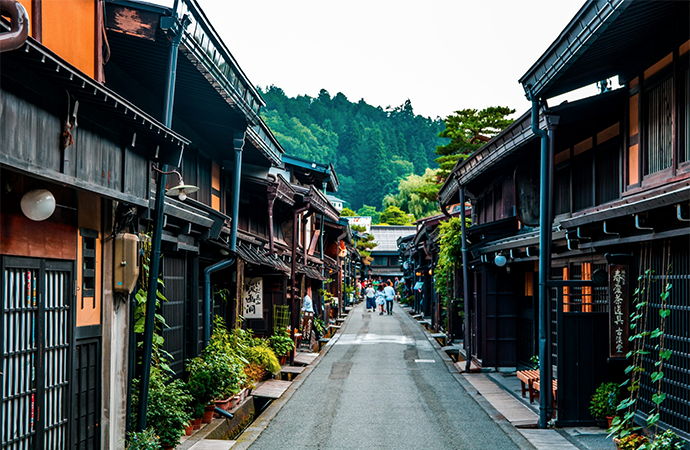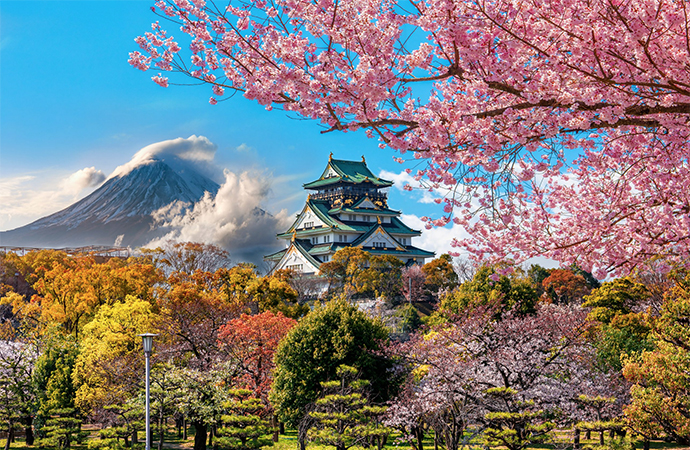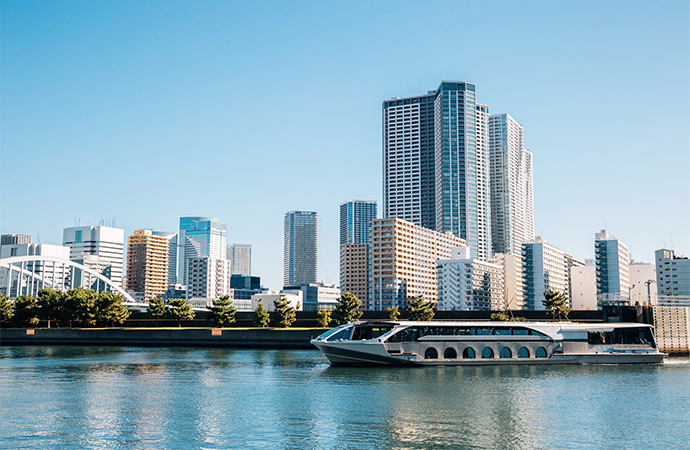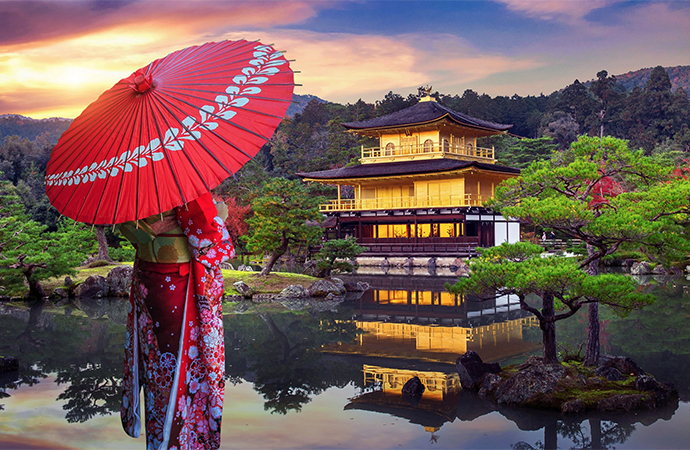-
Itinerary 14 Days / 13 Nights
Day 1 – Tokyo
Arrive in Tokyo and transfer to your hotel. Check in, and spend the rest of the day exploring this famous mega-city at your leisure.
Day 2 - Tokyo
Discover the iconic sights of Tokyo with a guided tour, using Tokyo’s convenient and ultra-modern public transit.
First, stop at Meiji Jingu, Tokyo’s most famous shrine, dedicated to the late Emperor Meiji and a popular Shinto site for local weddings. Watch the city transform before your eyes as you take a walk down Omotesando. This broad, tree lined avenue features a multitude of fashion flagship stores designed by internationally renowned architects and is symbolic of modern Tokyo, located in the fashionable Harajuku district.
Hop on the subway to Asakusa, part of Tokyo’s Shitamachi, or old town. Asakusa is home to Tokyo’s oldest Buddhist temple and is the city’s oldest Geisha district. Wander around the surrounding streets, dotted with an array of traditional shops selling local artisanal products and souvenirs
Day 3 – Tokyo with optional day trips
Your final day in Tokyo is left to you to explore! Either take advantage of the morning to visit the iconic Tsukji Fish Market or wander about Tokyo’s world-class museums and art galleries.
A day trip can also be arranged in advance, taking the train to neighbouring sights such as Kamakura or Nikko. One of Japan’s former capitals, Kamakura is a delightful seaside town home to many ancient temples and the Daibutsu, a giant bronze Buddha. Nikko National Park is nestled up in the mountains and houses the extravagant Toshogu Shrine Complex and Mausoleum, a UNESCO World Heritage Site.
Day 4 – Tokyo to Hakone
Wake up early and catch your train to Hakone National Park, the gateway to Mt. Fuji. This small town is famous for its onsen, natural hot springs, and surrounded by an abundance of natural beauty.
Armed with your Hakone Transport Pass, take advantage of the numerous forms of transport and explore the many sights of the park. Ride the Guinness World Record-setting ropeway all the way up Mt. Owakudani, soaring over sulphurous fumes emanating from hot springs and rivers in this volcanic area. At the top, try the famous hardboiled egg, cooked at the source of the springs and add seven years to your life, according to local lore! Cruise on a majestic replica pirate ship across Ashinoko Lake, formed by a volcanic eruption over 3000 years ago! Then take a ride on Hakone Tozan switchback train, zigzagging though the mountains, with breathtaking views of the surrounding valleys.
Keep an eye out for a glimpse of Mt. Fuji, but keep in mind that he is notoriously shy and needs a clear day to be seen in full splendor.
Then, return for a rest in you ryokan, or traditional Japanese inn. With sliding doors, rice paper screens and tatami mats, it’s the ultimate onsen hot spring experience. That evening, change into your yukata, or lightweight kimono, for a sumptuous kaiseki dinner. Taste the refinement of Japanese heritage during with this opulent multi-course meal- it’s the epitome of Japanese cuisine.
Day 5 - Hakone to Takayama
Take one last soak in the onsen before your journey to Takayama. Ride the first leg of the world famous Shinkansen bullet train, travelling up to 230km/h! Change onto the Limited Express Hida Wideview for the one of the most scenic train routes in Japan, winding your way through tall mountains and stunning gorges.
Arrive in Takayama, nestled high in the Hida alpine region, and discover this beautifully preserved old town. Due to its previously inaccessible location, the town was cut off from the rest of Japan, and developed its own distinctive culture. Discover Takayama for yourself by visiting one of the town’s many sake breweries for a taste of the high quality local brew, before settling into your ryokan for the night and enjoying a soak in your onsen.
Day 6 - Takayama and Shirakawago
After breakfast, a stroll to the Miyagawa morning market, where locals come to sell artisanal goods and fresh produce. Try some of the region’s delicious fruit and vegetables.
Mid-morning, take a half day tour to Shirakawago, nestled in remote mountains along the Shogewa River Valley. Arrive in this UNESCO World Heritage Site and visit some of the centuries-old traditional gassho-zukuri farmhouses up close. Designed to look like hands in prayer, these farmhouses can withstand heavy snowfalls in the winter and have spacious attics for cultivating silk worms.
Day 7 – Takayama to Kanazawa
Start the day early as you continue onwards down to Kanazawa, a beautifully preserved castle town that was Japan’s cultural centre in the wealthiest region of the 17th Century.
For your free day, consider hoping on the Kanazawa Sightseeing Bus to see some of the major highlights in the city. Begin at the pristine Kenroku Garden, or ‘Six Attributes Garden,’ said to be a perfect garden comprising of the essential attributes: spaciousness, seclusion, artifice, antiquity, water-courses, and panoramas. Stroll through Ishikawa Gate to Kanazawa Castle and observe its distinctive tiles made from lead.
Finish up in the Higashi Chaya District, one of the three, well-preserved chaya districts in Kanazawa. A chaya, or ‘tea house,’ is the traditional location where geishas entertain their guests with traditional song and dance. There’s also a Hakuza, a shop selling Kanazawa’s specialty - gold leaf products, with an inner tearoom covered with gold!
Day 8 – Kanazawa
Discover more of this charming city on a second free day. Why not begin your day in the old samurai district, Nagamachi, where you can immerse yourself in the historical tradition of the samurai at Nomurake, a restored home showcasing artifacts from the golden era of these warriors.
For art lovers, head across town to the 21st Century Museum of Contemporary Art. Explore the grounds and take in its ultra-modern architecture and ever-changing exhibits. Then, stroll over to the D.T. Suzuki Museum, a uniquely designed homage to the man who brought Zen Buddhism to the western world.
You can also explore a plethora of temples in Kanazawa or immerse yourself in local culture and flavours with a visit to the bustling seafood market!
Day 9 – Kanazawa to Hiroshima
Hop back on the train for your journey to Hiroshima. Arrive in the afternoon, and head to the Peace Park and Museum for a sobering remembrance of the tragic event that occurred over half a century ago. Despite the heartbreaking history, the city’s message of peace and hope remains strong, especially in its vibrantly modern urban culture. Wander around town to see firsthand the relaxed atmosphere, wide boulevards, galleries, variety of foods and welcoming locals that Hiroshima is known for!
Day 10 – Hiroshima to Miyajima
Today, head off to see one of Japan’s most famous sites on your own by hoping on the ferry to Miyajima Island. This wooded island is a short ride from Hiroshima and home to one of the country’s most photographic sights, The Floating Torii Gate. This 6th-century shrine is a sacred Shinto site and gateway between the spirit and human realms.
Take your time exploring the island and its many shrines and temples while sampling local goodies, like maple leaf shaped cakes. Hike up Mt. Misen, the island’s peak and savour spectacular views of the surrounding islands.
Day 11 – Hiroshima to Kyoto
Bid farewell to Hiroshima, and hop on the Shinkansen for a final ride to Japan’s cultural capital, Kyoto. Home to an astonishing 2,000 shrines and temples, including 17 UNESCO World Heritage Sites, this destination will have you enraptured in the ancient customs of Japan.
Upon arrival, enjoy the rest of the day exploring this famous city at your leisure.
Day 12 – Kyoto
Today, dive into a tour of the former imperial capital with a knowledgeable local guide, utilizing Kyoto’s convenient bus and subway system to visit some of its iconic World Heritage Sites.
Travel to Nijo Castle, built by the founder of the Edo Shogunate. Observe the momoyama architecture, decorated sliding doors and ‘chirping’ nightingale floors as you stroll through the palace grounds. Venture onwards to Ryoan-ji, the site of Japan's most famous rock garden. Get a glimpse of Zen Buddhist tradition as you gaze onto the precisely arranged stones. Sit back on the patio and consider the significance of this meditative spot, before you head to Kinkakuji, or the Golden Pavilion. Originally a retirement villa for the Shogun, Kinkakuji is now a Buddhist temple and one of the most famous sights in all of Kyoto.
In the afternoon, enjoy a guided stroll in Kyoto’s most charming district, Higashiyama. Begin with Kiyomizu Temple, taking in the incredible vistas of the city from the 13-meter high veranda jutting out from the main hall. Marvel at its’ unique architecture, built without the use of nails or any kind of joiners. Descend, and wander around Higashiyama’s busy lanes, enjoying the array of quaint shops selling souvenirs including Kiyomizu-yaki pottery, sweets and pickles.
Day 13- Kyoto and optional day trip
Meet your private guide at Yasaka Shrine in Gion. Founded over 1350 years ago, the shrine connects the Geisha District of Gion with the beautiful Higashiyama Temple District.
Walk through Higashiyama to partake in a 400 year old Japanese Tea Ceremony called Sao or Cha-no-yu. The tea ceremony is conducted in the decorated rooms of a traditional house.
Spend some time exploring Ninenzaka, which is a preserved area with restored shop houses where you can imagine what Kyoto looked like before modernity descended.
Next visit Kodaiji Temple. Established in 1606 and belonging to the Rinzai sect of Zen Buddhism, the lavish main buildings and richly decorated interiors are surrounded by beautiful Zen gardens.
In the afternoon, consider heading out of town on a short train ride to Nara with your Japan Rail Pass. Nara was the capital of Japan during the 8th century and still houses many well preserved temples and shrines. If you add Nara to your tour, be sure to visit Todaiji Temple, the largest wooden building in the world, or Kasuga Taisha, Nara’s most celebrated shrine. A stroll through Nara Park is a must, known to the locals as “deer park” due to the large population of tamed deer who reside there.
Day 14 – Depart Kyoto
Take advantage of your final hours in this historic city, wandering and enjoying some traditional food. Your Japan Rail Pass covers your travel for today and you can use it to travel to Kansai Airport in Osaka or return to Tokyo for your onward journey.
Please note on hotels in Japan:
Check-in time is 3.00PM and check-out time is 11.00AM. Early or late service is subject to availability with surcharge.
The Experience
For the perfect first-time visitor, explore the very best of Japan on an illuminating journey from Tokyo to Kyoto. From frenetic urban streets to historic icons, this highlights tour encompasses the dynamic and fascinating allure of Japan in two weeks.
Detailed itinerary
Open all
Reviews on Our Service
You May Also Like...
Recommended hotels in Southeast Asia
TAILOR-MADE HOLIDAY
Plan your luxury vacation with our travel experts help plan. Speak with a Luxury Travel expert via WHATSAPP: +84902011200 or Email at info@halongbaytrips.com









 In-Depth Knowledge with Local Insight
In-Depth Knowledge with Local Insight 


